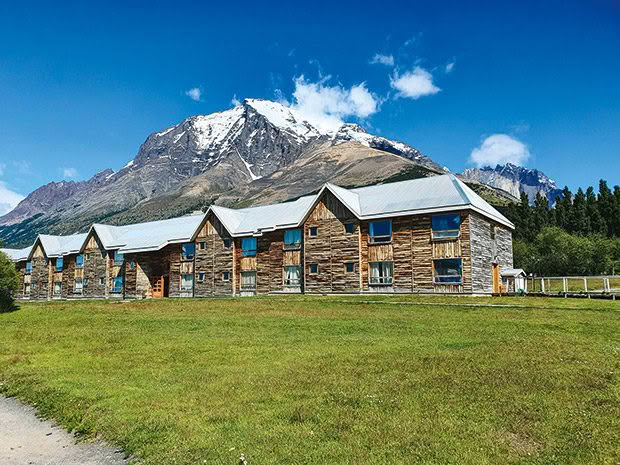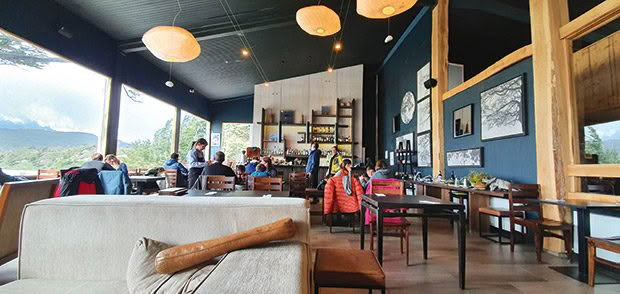The W Trek: Why this rugged 80km walk through Patagonia is entirely worth it

This five-day hiking adventure through a Patagonian paradise is wild, wonderful and undeniably world-class.
Words: Claire McCall Photos: James Baldwin
Winter bathing. Walk slowly but steadily into the water. Do not dive. Do not hesitate. This advice about the dubious merits of a daily plunge into the icy cold is shared at the communal dinner table in Refugio Los Cuernos — the backpacker-like accommodation in the million-dollar setting of Torres del Paine National Park, Chile.
Beyond the windows, the snowy steeples of the Andes rise from the shores of Lake Nordenskjöld, where our dinner companions, hardy and hearty, have recently taken a dip.
The W Trek in Patagonia is an internationally renowned five-day hike for a good reason. The arms of the ‘W’ take trampers into carved valleys alongside the mountains on a well-marked trail that runs through this world-heritage-listed region. Around every corner, there are wow moments: monumental granite peaks, magnificent glaciers, subpolar forests and milky-green or grey-blue lakes.

The author on day one towards the end of an eight-hour walk.
We have completed the second day of our 80-kilometre experience. While there are parallels with a multi-day hike in New Zealand (the scenery is like parts of the South Island — only amplified tenfold), there are pleasant dichotomies too. Here, at the end of the road at the far end of earth, there is the opportunity for a hot (well, warmish) shower, a bunkbed with real sheets and blankets and, best of all, cocktails from the on-site bar to toast the virtues and vagaries of the trail.
Yes, you read that right. The inclusion of bars in the mountain huts makes for just the right amount of challenge tempered with a little luxury.
The W can be walked west to east or vice versa, but we began with the most challenging day (a 1200-metre climb to the Torres del Paine, walking east to west). It was January 1, and we had spent the previous evening in Puerto Natales, the gritty but charming port town that is the gateway to the park.

The flags of Chile and Patagonia fly outside the Refugio Cerro Paine Grande.
Having booked nowhere for dinner, we wandered the streets, being turned away several times until we begged a seat at the work counter of one local eatery and — papers and calculators pushed aside — settled in with a bottle of rather-moreish Chilean chardonnay. A couple of hours later, there was still no table to be had, and when we got up to leave and head to our bed in a converted shipping container, the proprietor insisted we needn’t pay for the wine. Naturally, we refused. His hospitality called for another bottle to be ordered…
Here then, is a snapshot of a New Year’s Day to remember: a last-minute dash to the bus station with full packs and fuzzy heads when it became apparent our 6.30am taxi was not going to arrive; a classic bus ride with a driver whose Che Guevara-style beard and beret gave an authentic edge to the journey; and an eight-hour ramble then scramble up then back down a hillside in 32-degree Celsius heat (yes, temperatures vary widely).
Let’s make this clear: this 26-kilometre part of the trek is not easy — it’s rugged terrain and it’s long. But it is worth it.

A rocky, steep approach to the Torres del Paine but the view is worth the effort.
Words such as “iconic”, “breathtaking” and “spectacular” can never do the towers after which the park is named justice. It goes beyond imagination. You have to physically be there in the amphitheatre of water and stone to get the visceral magic of the place. Sadly, you also have to be able to subtract the Instagram poseurs from the picture mentally.
At the beginning and end of the W, arguably where the most awe-inspiring views are, there is, naturally, easier access to the trail. Day-trippers come in by boat or bus, and it’s difficult for New Zealanders to fathom that there are hotels within a decent stroll of the route for such a wild location.

The Grey Glacier, at six kilometres wide, is a branch of the Southern Patagonia Ice Field.
But in between, where there are only refugios supplied by horseback and designated camping sites, things are quieter. Meeting these in-betweeners, hikers who spend six hours per day steeped in a landscape that inspires contemplation and awe, makes the journey even more special.
It’s a balm to see the best of the human spirit in action — an outstretched hand to negotiate a shallow river crossing, the sharing of personal experience about time and distance (hint: take the mileage information offered on official signage with a handful of salt), and the slow-growing camaraderie that blooms in a place of such natural stature.

Tent sites at the Refugio Grey.
Over a glass of pale ale, brewed near the frigid Straits of Magellan, and following a dinner of, for example, soup, bean casserole and chocolate-brownie dessert, the post-hike ambience is warm and companionable.
It’s a gathering of nationalities united: a couple from Washington DC who enter into conversations about Trump and the failures of the political system and the United States drug industry; a group of four young French girls who like to play a card game called Exploding Kittens they seem to find hilarious; a Lithuanian software developer for Airbus now living in Singapore whose serious, strategy-based focus melts away to relaxed fortitude; and a Belgian diplomat who surveys the international scene with quiet yet no doubt astute observation.

Hotel Las Torres (where the posh people stay) is a 10-kilometre walk from the towers (“torres del paine” means “blue towers”.
The only other New Zealander we meet on the trail is of Indian descent. She kindly offers me some juice from her power pack when the hut charging points seem incompatible with my phone. Half-joking and, with the benefit of hindsight, she admits “there were tears” when she vastly underestimated the distance between two of the refugios. Even so, she acknowledges the silver lining: a fellow hiker donated his pizza when she arrived too late for dinner.
So we meet a refreshing mix of people and see a new batch of wildlife. There are grey foxes that stray across the path, vicunas (a llama relative) graze in familial groups on faraway hillsides and even a chimango caracara falcon that comes to drink from a stream a few metres in front of us. We can’t decide whether to be pleased or disappointed that we do not see a patagonian puma.

The dining room at Refugio Torres Norte.
After days where the weather changed as much as the scenery, from that initial blue-sky scorcher to a mizzle-misted amble alongside a lake to the French Valley and on towards the Grey Glacier the first glimpse of which is guaranteed to elicit an expression of wonder, we arrived at the final stretch. An andean condor drifted by as we were waiting for the boat that would get us up close and personal with the glacier, its massive wingspan in proportion with the expanse of the landscape. Chunks of ice, some impossibly blue, float sculpturally in the water.
The Grey Glacier in the Southern Patagonian Icefield is six kilometres wide and some 30 metres high. It stretches 28 kilometres and has an island of land in the middle of it – a nunatak – from which intrepid adventurers can book a guided tour to walk its fractured landscape.

Supplies are brought in to some of the more remote refugios on horseback.
On board, a brisk wind whipping colour into our cheeks, a complimentary “pisco sour” chilled with glacial ice in hand, we approach its face. Soon to be calved from its front, the milk-blue forms are a family of ghosts, a mute gathering that bears silent witness to the inevitability of their own demise.
GETTING THERE

A chimango caracara.
We took a direct flight (Auckland to Santiago de Chile) on Latam Airlines. Because the distances in Chile are vast (at 4270 kilometres north to south, it is the longest country in the world), we also traveled domestically with Latam, flying from Santiago to Punta Arenas, then catching the Bus Sur (bussur.com) to Puerto Natales in Patagonia, where we needed to overnight. An early morning bus on Bus Gomez took us to the entrance to the Torres Del Paine National Park.
Organizing the W: Decide which direction you would like to walk the W. Then, you can book accommodation in the park yourself (visit the website torreshike.com) either in tents or refugios (serviced huts, obligatory to book), but you will still need to be adept at planning a multi-day hike. There are options for a three-, four- or five-day hike.
Bookings, which are in high demand, open about May to July for dates in the summer season. Ideally, get organized early (a year in advance) if you don’t want to miss out. Plus, don’t forget to book a park entrance ticket online beforehand, as tickets can no longer be bought at the gate. We found it easier to book the entire trip with a company and used Swoop Travel (swoop-adventures.com) and its on-ground partner Dittmar Adventures (dittmaradventures.com), which organized the itinerary, booked refugios (with all meals etc), the boat trip to Grey Glacier and the bus to and from Puerto Natales to the park.
What to take: Hiking gear for all eventualities (from snow to rain to full sun), including trekking boots, money in Chilean pesos to buy drinks and incidentals, plus a good camera. A sleeping bag may or may not be needed depending on the package. Take food if you haven’t booked a meal package.
Love this story? Subscribe now!
 This article first appeared in NZ Life & Leisure Magazine.
This article first appeared in NZ Life & Leisure Magazine.
